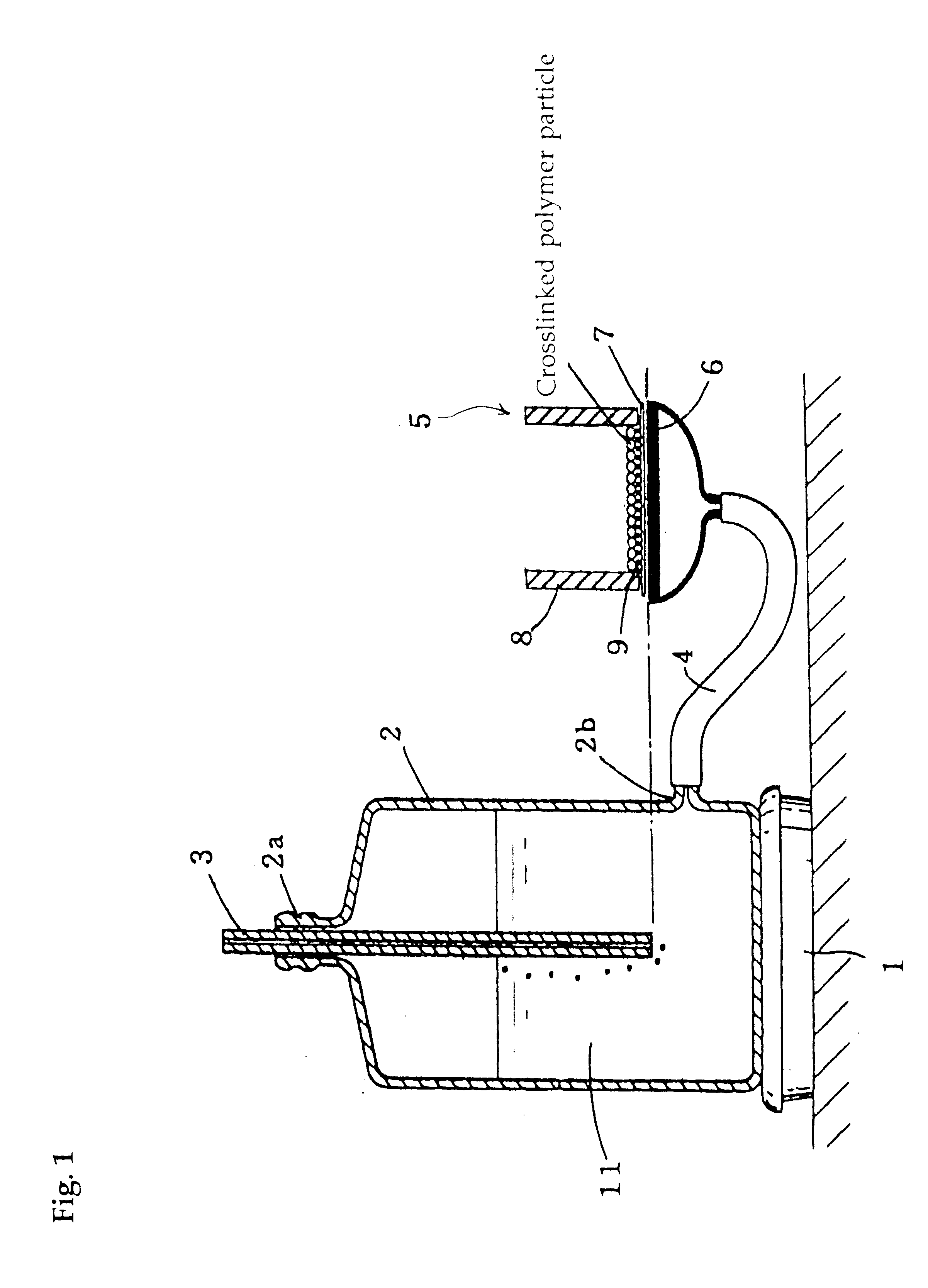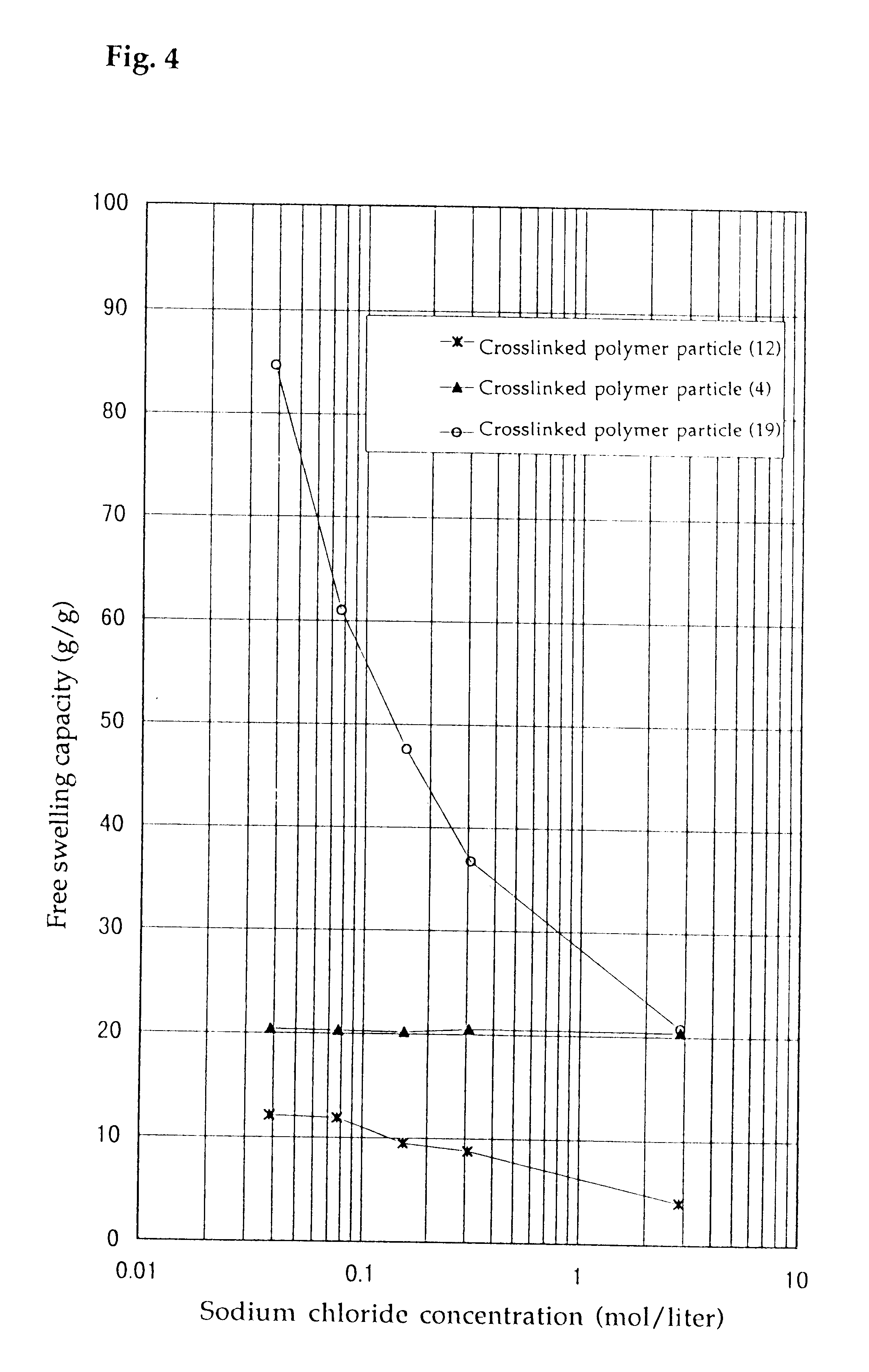Crosslinked polymer particle and its production process and use
a technology of crosslinked polymer and production process, which is applied in the field of crosslinked polymer particle and its production process and use, can solve the problems of reducing the heat resistance, deteriorating the water absorption properties of the crosslinked polymer, and unfavorable surfactants in view of safety, and achieves the effect of easy control of the siz
- Summary
- Abstract
- Description
- Claims
- Application Information
AI Technical Summary
Benefits of technology
Problems solved by technology
Method used
Image
Examples
example 2
First, 250 g of n-hexane solution, containing 0.5 g of inorganic particle (trade name: Aerosil R972, made by Nippon Aerosil Co., Ltd.) and 0.1 g of sorbitan monostearate, was placed into a separable flask of 500 cc with a dropping funnel, a stirrer, a thermometer, and a reflux condenser, and then stirred at room temperature. Next, 2.68 g of 50% aqueous solution of ethylene glycol diglycidyl ether (trade name: Denacol EX-810, made by Nagase Chemicals, Ltd.) (as the crosslinking agent) was added under stirring to a hydrophilic high-molecular compound solution having been cooled to 0.degree. C. beforehand and comprising 41.7 g of 30% polyethylenimine (trade name: Epomin P1000, made by Nippon Shokubai Co., Ltd.) and 29.6 g of pure water, and the resultant mixed solution was dropped to the above n-hexane solution at room temperature under stirring. Under stirring, the temperature of the system was gradually raised to 60.degree. C., and the reaction was carried out at 60.degree. C. for 3 ...
example 3
First, 10 liters of cyclohexane solution, containing 100 g of inorganic particle (trade name: Aerosil R972, made by Nippon Aerosil Co., Ltd.), was placed into a stainless bottle of 20 liters with a dropping funnel, a stirrer, a thermometer, and a reflux condenser, and then stirred at room temperature. Next, 363 g of 50% aqueous solution of ethylene glycol diglycidyl ether (trade name: Denacol EX-810, made by Nagase Chemicals, Ltd.) (as the crosslinking agent) was added under stirring to a hydrophilic high-molecular compound solution having been cooled to 0.degree. C. beforehand and comprising 5,636 g of 30% polyethylenimine (trade name: Epomin P1000, made by Nippon Shokubai Co., Ltd.) and 4,000 g of pure water, thus preparing an aqueous solution containing a crosslinking agent and a hydrophilic high-molecular compound. Then, this solution was added to the above cyclohexane solution at room temperature under stirring. Under stirring, the temperature of the system was gradually raised...
example 4
First, 600 ml of cyclohexane solution, containing 6 g of inorganic particle (trade name: Aerosil R972, made by Nippon Aerosil Co., Ltd.), was placed into a separable flask of 2 liters with a dropping funnel, a stirrer, a thermometer, a reflux condenser, and a built-in baffle, and then stirred at room temperature. Next, 13.8 g of 52% aqueous solution of ethylene glycol diglycidyl ether (trade name: Denacol EX-810, made by Nagase Chemicals, Ltd.) (as the crosslinking agent) was added under stirring to an aqueous hydrophilic high-molecular compound solution having been cooled to 0.degree. C. beforehand and comprising 337.2 g of 30% polyethylenimine (trade name: Epomin P1000, made by Nippon Shokubai Co., Ltd.) and 249 g of pure water, thus preparing an aqueous solution containing a crosslinking agent and a hydrophilic high-molecular compound. Then, this solution was added to the above cyclohexane solution at room temperature under stirring. Under stirring, the temperature of the system ...
PUM
| Property | Measurement | Unit |
|---|---|---|
| average primary particle diameter | aaaaa | aaaaa |
| average primary particle diameter | aaaaa | aaaaa |
| diameter | aaaaa | aaaaa |
Abstract
Description
Claims
Application Information
 Login to View More
Login to View More - R&D
- Intellectual Property
- Life Sciences
- Materials
- Tech Scout
- Unparalleled Data Quality
- Higher Quality Content
- 60% Fewer Hallucinations
Browse by: Latest US Patents, China's latest patents, Technical Efficacy Thesaurus, Application Domain, Technology Topic, Popular Technical Reports.
© 2025 PatSnap. All rights reserved.Legal|Privacy policy|Modern Slavery Act Transparency Statement|Sitemap|About US| Contact US: help@patsnap.com



